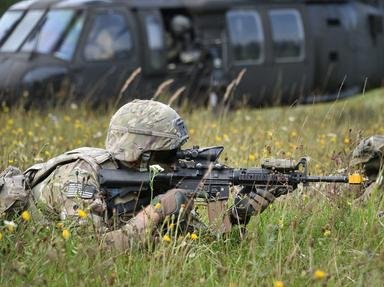Quiz Answer Key and Fun Facts
1. After stacking up, what technique do operators typically do to signal they are ready to move, assuming Stealth Entry conditions?
2. What one-word phrase is often used to indicate that a bomb or improvised explosive device is in sight?
3. Although all of the following military units practice CQB tactics to some degree, which of them is generally considered to be the foremost at operating in a CQB environment?
4. A particular type of bullet was developed in the early 1990's specifically for use by teams operating in a CQB environment where the chance of collateral damage from an overpenetration or miss was extremely high, such as pressurized airplane cabins or civilian structures in populated areas. What is this bullet type called?
5. The UMP (Universal Machinenpistole) submachinegun from Heckler & Koch is quickly becoming a popular entry weapon for CQB teams. It is powerful, lightweight, and compact. In what caliber was the UMP first introduced?
6. SWAT and military entry teams train in the tactic of "cooking off" a grenade, to prevent enemies or suspects from throwing the grenade back at them.
7. Although SWAT snipers typically don't make entry into the CQB environment, they are often a very valuable resource to have on the outside, for support and surveillance. At what range do these snipers usually set up for situations like this?
8. CQB entry teams use shotguns for multiple purposes, with specialty loads for each purpose. Which type of shotgun load is NOT used by a CQB entry team?
9. Many teams, both military and police, practice their CQB tactics in a structure known as a "Kill House".
10. The "no-reflex shot" is a shooting stance designed to allow a military CQB operator to engage a target with a minimum of conscious thought, and is only used in situations where there are NO friendlies or hostages.
Source: Author
Stillman
This quiz was reviewed by FunTrivia editor
thejazzkickazz before going online.
Any errors found in FunTrivia content are routinely corrected through our feedback system.


